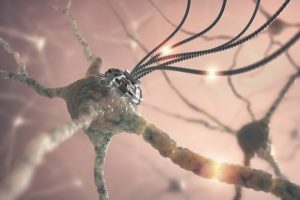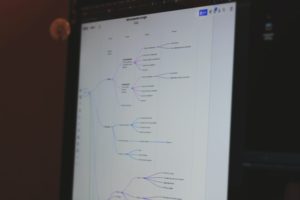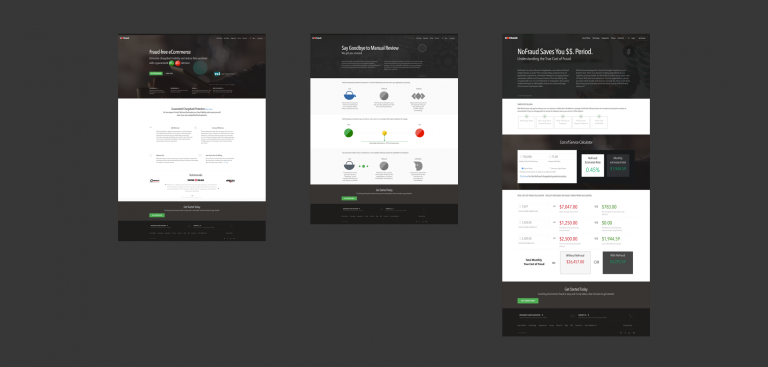It’s behind the Tesla autopilot feature. It’s your recommendations from Netflix. It’s when Siri recognizes your speech and serves you results. It’s the foundation for your credit card’s fraud detection technology. We see the application of neural networks and machine learning all around us today in nearly every aspect of life.
With the exponentially increasing volumes and varieties of data, the advent of cheaper and faster computational processing, and ubiquitous affordable mass data storage, neural networks aren’t just for Google and Microsoft anymore. It’s important for small and medium business owners to know what neural networks are, what they can do for their business, and also what their limitations are.
So What is a Neural Network?
Let’s grab a definition from Dr. Robert Hecht-Nielsen, an early pioneer in neural networks in the 1980s and 1990s. He defines an artificial neural network (ANN) as:
“…a computing system made up of a number of simple, highly interconnected processing elements, which process information by their dynamic state response to external inputs.”
An ANN mimics certain features of the brain’s physical structure and information processing, with a web of neural connections that consist of myriad interconnected and layered simple processing elements. Akin to its biological sibling, in an ANN:
1. Each processing element (essentially a neuron) receives inputs from other elements
2. The inputs are weighted and added,
3. The result is then transformed (by a transfer function) into the output.
The transfer function may be a step, a sigmoid function (S-curve), or hyperbolic tangent function, among others.

ANNs are basic learning devices in the form of hardware or software. In both cases, the fundamental idea is to assemble several single simple processors that interact through a dense web of interconnections, which result in a network architecture that is unlike the sequential linear processing and architecture of conventional computer systems.
How do Neural Networks Differ from Conventional Computers?
Conventional computers are good at numerical computation; they apply formulas, decision rules, and algorithms instructed by users to produce outputs from the inputs. A neural network, on the other hand, is not a general-purpose problem solver. It is good at complex numerical computation for the purposes of solving system of linear or non-linear equations, organizing data into equivalent classes, and adapting the solution model to environmental changes. But it is not good at such mundane tasks as calculating payroll, balancing checks, and generating invoices. Nor is it good at logical inference – a job suited for expert systems. Therefore, business leaders must know when a problem could be solved with an ANN; moreover, to make an ANN work, it must be tailored specifically to the problem it is intended to solve.
ANNs, like people, learn by example. They improve their own rules; the more decisions they make, the better the decisions may become. Data scientist and entrepreneur Jeremy Howard describes this phenomenon quite colorfully:
The difference here is each thing builds on each other thing. The data and the computational capability are increasing exponentially, and the more data you give these deep-learning networks and the more computational capability you give them, the better the result becomes because the results of previous machine-learning exercises can be fed back into the algorithms. That means each layer becomes a foundation for the next layer of machine learning, and the whole thing scales in a multiplicative way every year. There’s no reason to believe that has a limit.
An ANN is configured for a specific application, such as pattern recognition or data classification, through a learning process. Think of it simply as a branch of statistics, designed for a world of big data, where the most common application of machine learning is to make predictions.
Applying Neural Networks to Different Industries
Because a neural network must be built and tailored specifically to the problem it is intended to solve, you can’t just slap on a machine learning solution someone else did for their own context and set of data. The best way to determine if you can leverage neural networks in your own business and then reap the gains achieved by them is to learn and understand how neural networks intersect and function across a breadth of different industries; this will inform your own specific situation. I’ve shared several examples for you below.
Marketing
In marketing, we identify customers likely to respond positively to a product or service, and target any advertising or solicitation towards them. Target marketing involves market segmentation, where we divide the market into distinct groups of customers with different consumer behavior. Neural networks are well-equipped to carry this out by segmenting customers according to basic characteristics including demographics, socio-economic status, geographic location, purchase patterns, and attitude towards a product.
Unsupervised neural networks can be used to automatically group and segment customers based on the similarity of their characteristics, while supervised neural networks can be trained to learn the boundaries between customer segments based on a group of customers with known segment labels, for example: frequent buyer, occasional buyer, rare buyer. Machine learning can save your organization both time and money by ensuring that you avoid contacting customers who are unlikely to respond. One study showed that neural networks can be used to improve response rates from the typical one to two percent, up to 95%, simply by choosing which customers to send direct marketing mail advertisements to. Neural networks can also be used to monitor customer behavior patterns over time, and to learn to detect when a customer is about to switch to a competitor.
Retail & Sales
Neural networks are excellent in the realm of sales forecasting, due to their ability to simultaneously consider multiple variables such as market demand for a product, a customer’s disposable income, population size, product price, and the price of complementary products. Forecasting of sales in supermarkets and wholesale suppliers has been shown to outperform traditional statistical techniques like regression, as well as human experts.
Another important area where retail and sales can benefit from neural networks is in shopping cart analysis, such as gathering and inputting information relating to which products are often purchased together, or the expected time delay between sales of two products.
Retailers can use this information to make decisions about the layout of the store: if shopping cart analysis reveals a strong association between products A and B then they can entice consumers to buy product B by placing it near product A on the shelves. If there is a relationship between two products over time, say within 6 months of buying a printer the customer returns to buy a new cartridge, then retailers can use this information to contact the customer, decreasing the chance that the customer will purchase the product from a competitor.
Banking & Finance
One of the main areas of banking and finance that has been affected by neural networks is trading and financial forecasting. Neural networks have been applied successfully to problems like derivative securities pricing and hedging, futures price forecasting, exchange rate forecasting and stock performance and selection prediction since the 1990s.
But there are many other areas of banking and finance that have been improved through the use of neural networks. For many years, banks have used credit scoring techniques to determine which loan applicants they should lend money to. Traditionally, statistical techniques have driven the software. These days, however, neural networks are the underlying technique driving the decision making. Credit scoring systems can learn to correctly identify good or poor credit risks. Neural networks have also been successful in learning to predict corporate bankruptcy.
Insurance
The insurance industry can leverage neural networks in a similar means as the marketing industry: policy holders can be segmented into groups based upon their behaviors, which can help to determine effective premium pricing. And like the banking and finance sectors, the insurance industry is constantly aware of the need to detect fraud – neural networks can be trained to learn to detect fraudulent claims or unusual circumstances. Competition is fierce in the insurance industry, and when a policy holder leaves, useful information can be determined from their history which might indicate why they have left. Using machine learning to manage the offering certain customers incentives to stay, like reducing their premiums, or providing no-claims bonuses, can help to retain good customers.
Telecommunications
Machine learning offers telecommunications organizations a clear opportunity to ascertain a much more complete picture of their operations and their customers, as well as to further their innovation efforts. Some companies are using a series of neural networks to analyze customer and call data in order to predict if, when, and why a customer is likely to leave for another competitor. Many telecommunications organizations use machine learning to help predict the effects of forthcoming promotional strategies, as well as sift through and refine data to find the most profitable customers.
Other uses of neural networks in telecommunications include:
– Optimizing routing and quality of service by analyzing network traffic in real time
– Analyzing call data records in real time to identify fraudulent behavior immediately
– Allowing call center reps to flexibly and profitably modify subscriber calling plans immediately
– Tailoring marketing campaigns to individual customers using location-based and social networking technologies
-Using insights into customer behavior and usage to develop new products and services
Operations management
Neural networks have been used successfully in operations management, particularly in the areas of scheduling and planning. R&D regarding the scheduling of machinery, assembly lines, and cellular manufacturing using neural networks has been increasingly prevalent over fifteen years. Other scheduling problems, like timetabling, project scheduling, and multiprocessor task scheduling have also been addressed with neural networks.
The use of neural networks in various operations planning and control activities cover a broad spectrum of application, from demand forecasting, to shop floor scheduling and control. Neural networks have also been used in conjunction with simulation modeling to learn better manufacturing system design.
Operations management also benefit from neural networks in the area of quality control, as neural networks can be integrated with traditional statistical control techniques to enhance their performance. Examples of this include a neural network used to monitor soda bottles to make sure each bottle is filled and capped properly.
Neural networks can also be used in diagnostics, and have been used to detect faults in electrical equipment and satellite communication networks. Project management tasks have also been tackled by using neural networks to forecast project completion times for knowledge work projects, or to predict workloads and delivery times in software engineering and development projects.
Conclusion
It’s apparent that the application of neural network technology is having disruptive effects and is becoming more and more pervasive in common business operations – even across the SMB market – with every passing day. My advice for business leaders is to take the time to thoroughly learn and understand what the technolgy implies, so you may begin to identify use cases and scenerios within your own business ecosphere. Research and identify the possible opportunities or insights that may be gleaned by plugging into Big Data and/or employing data vendor systems. And by all means, seek the consultation of an expert – one that seeks to highlight and understand the key critical functions of your business, that identifies what parts and/or interaction points you need to improve, and then helps you articulate a realistic, cohesive plan to develop a scalable solution.
Sources
Chartiere, Tim. Big Data: How Data Analytics Is Transforming the World.
Lee, Eldon. Artificial neural networks and their business applications.
Smith, Kate and Jatinder, Gupta. Neural networks in business: techniques and applications for the operations researcher.







